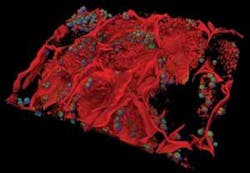To make sure we stay on course and benefit from the great promise that 21st century bioscience research offers, the National Institute of Standards and Technology (NIST; Bethesda, MD) has added a new component to its portfolio of measurement and standards activities: bioscience. Best known for its calibration and reference expertise in the physical, chemical, and information sciences NIST will put that knowledge to work to improve a number of bio-related areas including the accuracy of medical diagnostics and treatment, monitoring of infectious diseases and bioterrorism agents, and environmental threat assessment.
“People don’t realize how few measurement standards exist,” says NIST Chemical Science and Technology Laboratory (CSTL) Director Willie May. “There is no more certain threat to the success of the biosciences than a lack of standards.” In laboratory medicine, for instance, common tools such as mass spectrometry, immunoassays, and even microscopy lack uniform calibration standards. “There is nothing to provide an anchoring truth,” says colleague Michael D. Amos, bioscience advisor, NIST CSTL. In the case of fluorescence microscopy, standards are badly needed for quantifying low light levels.
While NIST has not played a major role in measurement and standards development in bioscience, it has, throughout its history, made an impact in dentistry, dosimetry standards for x-rays and laboratory references for tests on electrolytes and metabolites as well as protein, peptide, and DNA-based biomarkers.
Moving forward to develop standard references in biosciences will help U.S. industry as well as consumers. “The bioscience sector is growing and is facing large measurement challenges. Our job is to support U.S. innovation and competition,” says Jason Boehm, Acting Director, NIST Program and Planning Office.
The sooner the better considering that standards development can take up to 10 years. Better data based on reproducible standards will also mean that the big move to electronic health records could actually have a significant impact on healthcare. Individual test results that are comparable across time and space could help create a valuable medical data mine.
However, as May points out, current laboratory test results are not comparable and “if the clinical diagnostic data can’t be compared, e-records won’t have the impact everyone thinks they’ll have.”
Further reading
Measurement Challenges to Innovation in the Biosciences: Critical Roles for NIST http://www.cstl.nist.gov/Bioscience%20Conference/MeasurementChallengestoInnovationinBiosciences_NIST.pdf March 2009
Accelerating Innovation in 21st Century Biosciences: Identifying the Measurement, Standards, and Technological Challenges, October 19-22, 2008 Conference Report http://www.cstl.nist.gov/Bioscience%20Conference/NIST_Conference_Report.pdf July 2009
About the Author

